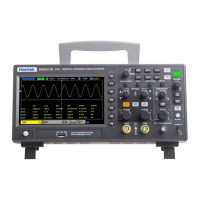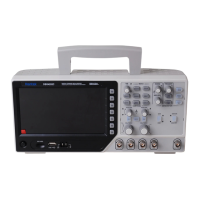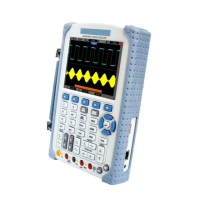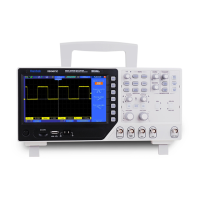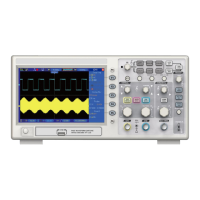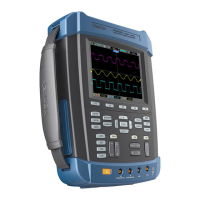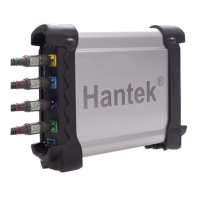21 / 72
Using Cursors to measure FFT waveform
To make cursor measurements, press the Cursors button to turn the cursors, and then press the Mode
softkey to select Manual or Track, Use the AX and BX cursors to measure frequency values and the
difference between two frequency values (BX-AX). Use the AY and BY cursors to measure amplitude in
dB and difference in amplitude (BY-AY).
2.7. Trigger System
The trigger determines when the oscilloscope begins to acquire data and display a waveform. Once a
trigger is properly set up, the oscilloscope can convert unstable displays or blank screens to meaningful
waveform. Here introduce some basic concepts about trigger.
Trigger Source: The trigger can be generated with multiple sources. The most common one is the input
channel (CH1~CH2). Whether the input signal is displayed or not, it can trigger normal operations. Also
the trigger source can be any signal connected to an external trigger channel (only for Edge trigger).
Trigger Mode: You can select the Auto or Normal mode to define how the oscilloscope acquires data
when it does not detect a trigger condition. Auto Mode performs the acquisition freely in absence of
valid trigger. It allows the generation of untriggered waveform with the time base set to 100ms/div or
slower. Normal Mode updates the displayed waveform only when the oscilloscope detects a valid
trigger condition. Before this update, the oscilloscope still displays the old waveform. This mode shall
be used when you want to only view the effectively triggered waveform. In this mode, the oscilloscope
displays waveform only after the first trigger. To perform a single sequence acquisition, push the [Single]
button.
Trigger Position: The horizontal position control establishes the time between the trigger position and
the screen center.
Trigger Level: It sets the amplitude level the signal must cross to cause an acquisition when using the
Edge or Pulse Width trigger.
Force Trigger: Used to complete an acquisition regardless of an adequate trigger signal. This button
becomes useless if the acquisition is already stopped.
Holdoff: To use Trigger Holdoff, push the Trig Menu button and press Holdoff softkey. The Trigger
Holdoff function can be used to generate a stable display of complex waveform (such as pulse trains).
Holdoff is the time between when the oscilloscope detects one trigger and when it is ready to detect
another. During the holdoff time, the oscilloscope will not trigger. For a pulse train, the holdoff time can
be adjusted to let the oscilloscope trigger only on the first pulse in the train.

